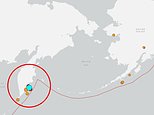A massive 7.8 magnitude earthquake has triggered tsunami alerts in Alaska, Hawaii, and across the Pacific Ocean. The quake struck near the Petropavlovsk-Kamchatsky region, off Russia’s east coast, on Thursday at 2:58 p.m. ET.
The National Oceanic and Atmospheric Administration’s (NOAA) tsunami warning system has announced that Hawaii is officially under threat from dangerous waves caused by the earthquake. Two tsunami watches have been issued for Alaska’s Aleutian Islands, the closest U.S. territory to the epicenter. This advisory covers an area from Attu to the Amchitka Pass, approximately 125 miles west of Adak, Alaska.
Residents in these regions are advised to avoid beaches, harbors, and low-lying coastal areas and to stay alert for updates as the waves are expected to arrive Thursday evening.
Meanwhile, Hawaii is forecasted to experience a tsunami with waves ranging from one to three feet high, expected to reach the state Thursday night. According to AccuWeather, the earliest arrival time for these waves is 8:51 p.m. ET. Currently, NOAA has issued an advisory-level alert for Hawaii, indicating that minor waves or strong currents may occur, but widespread flooding is unlikely.
No tsunami warnings have been issued for the U.S. West Coast. San Francisco, California, one of the closest major cities to the earthquake’s epicenter, is roughly 4,300 miles away, and seismic waves are not expected to reach that far.
In Russia, however, residents near the epicenter are under heightened alert as the tsunami warning system predicts waves between three and ten feet high. Such waves could lead to significant coastal flooding or damage, particularly in low-lying areas.
**What is a tsunami?**
A tsunami is a series of large ocean waves caused by a sudden disturbance in or near the sea, such as an earthquake or volcanic eruption. These waves can travel across entire oceans and cause flooding and destruction when they reach coastlines. Unlike regular waves, tsunamis can be very long and powerful, sometimes reaching heights of 10 feet or more, similar to those expected along the Russian coast.
**Recent seismic activity in Kamchatka Peninsula**
The Kamchatka Peninsula has been repeatedly struck by major earthquakes this summer. Notably, a magnitude 7.4 earthquake occurred on September 13, and a devastating magnitude 8.8 earthquake took place on July 29. Following the July event, millions were placed under tsunami advisories, including residents in Japan, Hawaii, and the U.S. West Coast.
The U.S. Geological Survey (USGS) has classified Thursday’s 7.8 magnitude earthquake as a giant aftershock of the larger July 29 quake. It is the largest recorded aftershock linked to that event near Russia’s coast.
USGS explains that the major earthquake was caused by a type of movement known as reverse faulting, where two massive pieces of the Earth’s crust push against each other. In this region, the Pacific Plate is sliding beneath the North American Plate at a rate of about three inches per year. This movement occurs along a vast underground boundary called the Kuril-Kamchatka subduction zone.
Since Thursday’s 7.8 magnitude quake, more than a dozen additional earthquakes have struck the region, all registering magnitudes above 4.6. Authorities continue to monitor the seismic activity closely and urge residents in affected areas to stay vigilant.
https://www.dailymail.co.uk/sciencetech/article-15112597/Millions-tsunami-threat-monster-7-8-earthquake-strikes.html?ns_mchannel=rss&ns_campaign=1490&ito=1490

